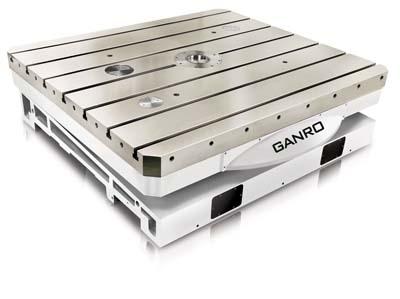
Ganro Industrial Corp. has made significant specification improvements to its horizontal rotary table series including the new HR-3030, which offers a new larger size table top and is available from CNC Indexing & Feeding Technologies.
The new HR-3030 CNC horizontal rotary table has a table top dimension of 3000mm (118.11"), 3905mm (153.75") table swing diameter, minimum indexing increments of 0.001 degrees, and a maximum work load capacity of 50,000 kg. or 110,230 lbs.
Changes to each of the current horizontal CNC rotary tables include upgrades to more powerful servo motors and stronger clamping torque with a newly designed hydraulic braking system. Also improved are work load capacities and additional built-in net weight for rigidity.
The HR Series is available with table tops ranging from 400mm (15.74") to 3000mm (118.11") square. Ganro's horizontal CNC rotary tables can be used in various areas of manufacturing but are ideal for horizontal boring mill applications. The HR Series design can be used as a full rotating axis incorporated into a machine's control or as an indexer with Ganro's M-Mate AC servo controller. They are designed for horizontal mounting only and offer high weight capacities for large workpieces. The HR Series rotary tables use a hydraulic brake system to insure rigid clamping during machining.
All Ganro horizontal CNC rotary tables and indexers use Ganro's core technology of a double lead worm shaft and worm wheel system for high precision and reduced backlash. Ganro rotary tables are assembled using cross cylindrical roller bearings with high rotation accuracy capable of bearing heavy loads in every direction.
Contact Details
Related Glossary Terms
- Rockwell hardness number ( HR)
Rockwell hardness number ( HR)
Number derived from the net increase in the depth of impression as the load on the indenter is increased from a fixed minor load to a major load and then returned to the minor load. The Rockwell hardness number is always quoted with a scale symbol representing the indenter, load and dial used. Rockwell A scale is used in connection with carbide cutting tools. Rockwell B and C scales are used in connection with workpiece materials.
- backlash
backlash
Reaction in dynamic motion systems where potential energy that was created while the object was in motion is released when the object stops. Release of this potential energy or inertia causes the device to quickly snap backward relative to the last direction of motion. Backlash can cause a system’s final resting position to be different from what was intended and from where the control system intended to stop the device.
- boring
boring
Enlarging a hole that already has been drilled or cored. Generally, it is an operation of truing the previously drilled hole with a single-point, lathe-type tool. Boring is essentially internal turning, in that usually a single-point cutting tool forms the internal shape. Some tools are available with two cutting edges to balance cutting forces.
- computer numerical control ( CNC)
computer numerical control ( CNC)
Microprocessor-based controller dedicated to a machine tool that permits the creation or modification of parts. Programmed numerical control activates the machine’s servos and spindle drives and controls the various machining operations. See DNC, direct numerical control; NC, numerical control.
- milling machine ( mill)
milling machine ( mill)
Runs endmills and arbor-mounted milling cutters. Features include a head with a spindle that drives the cutters; a column, knee and table that provide motion in the three Cartesian axes; and a base that supports the components and houses the cutting-fluid pump and reservoir. The work is mounted on the table and fed into the rotating cutter or endmill to accomplish the milling steps; vertical milling machines also feed endmills into the work by means of a spindle-mounted quill. Models range from small manual machines to big bed-type and duplex mills. All take one of three basic forms: vertical, horizontal or convertible horizontal/vertical. Vertical machines may be knee-type (the table is mounted on a knee that can be elevated) or bed-type (the table is securely supported and only moves horizontally). In general, horizontal machines are bigger and more powerful, while vertical machines are lighter but more versatile and easier to set up and operate.
